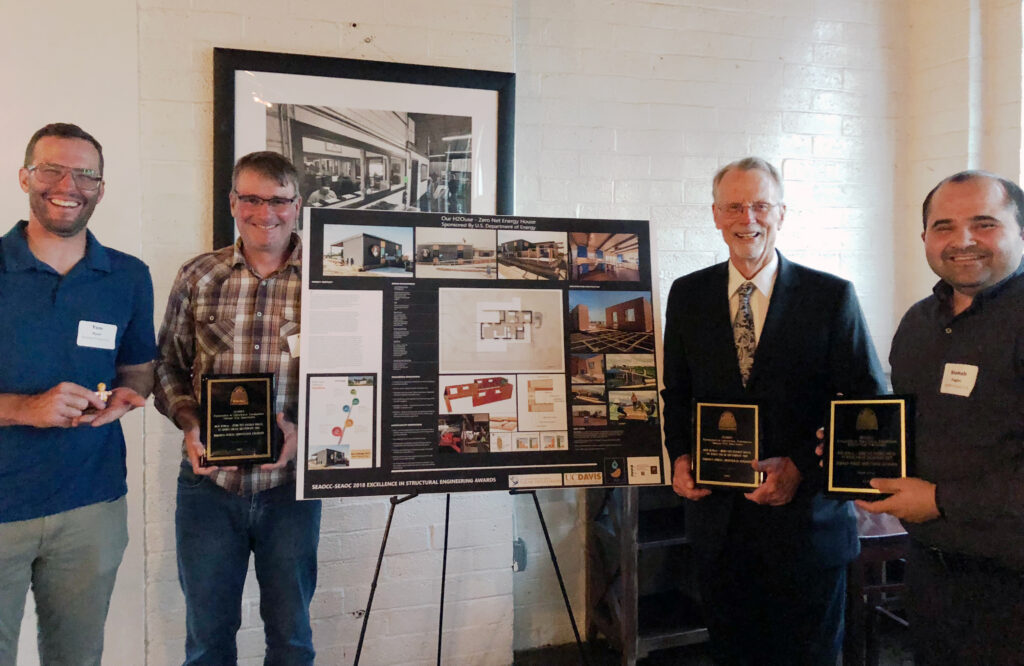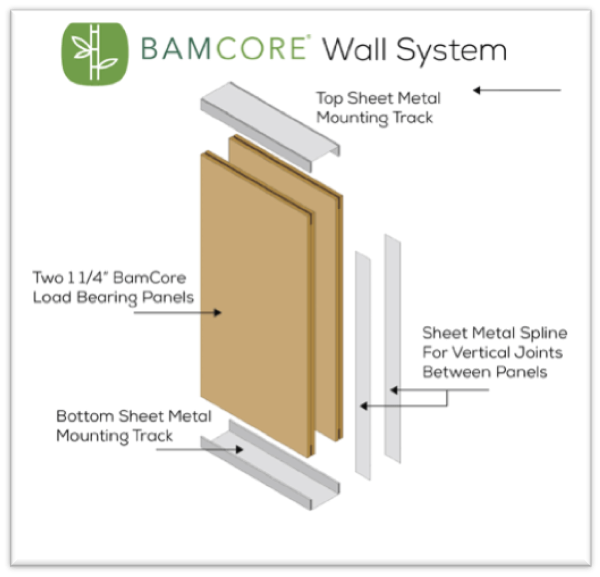
UC Davis Solar Decathlon team members at the Structural Engineers Association of Central California awards ceremony on June 12 in Sacramento. From left to right, Tom Ryan (project manager), Frank Loge (faculty lead), Norman Scheel (consulting expert), and Shahab Faghri (engineering manager).
In recognition of their outstanding achievements designing and building OurH2Ouse
“This experience and recognition will serve the students well as they enter the workforce and continue to drive the advancement of zero net energy homes.” – Professor Frank Loge
On June 12, 2018 the UC Davis Solar Decathlon team, led by Professor Frank Loge in the Department of Civil and Environmental Engineering, received the Excellence in Structural Engineering Award from the Structural Engineers Association of Central California (SEACC) for their work designing and building OurH2Ouse for the 2017 U.S. Department of Energy’s Solar Decathlon competition. This annual award recognizes excellence in structural engineering and project work in Central California. The team is now eligible for the larger state-wide Structural Engineers Association of California award, which will be announced in September.
“I am so proud of the UC Davis Solar Decathlon team. This award demonstrates the quality of the work they performed,” said Frank Loge. “This experience and recognition will serve the students well as they enter the workforce and continue to drive the advancement of zero net energy homes.”

OurH20use at the 2017 Solar Decathlon competition in Denver, Colorado.

Members of the UC Davis Solar Decathlon team.
OurH2Ouse
For many years, California has suffered from cyclically-occurring droughts. OurH2Ouse (pronounced “our house”) was designed to address this critical issue through three main design and engineering pillars: drought resilience, education, and inclusiveness.
- Drought Resilience is promoted through community-level systems of energy and water management. Water flow rates are monitored in all of the water lines and collected data is compared to customizable water budget goals. In addition, reclaimed and/or sustainable building materials are used throughout the home to lower the overall carbon footprint of the house and improve the home’s long-term energy and water efficiency.
- Education is achieved by influencing occupants, both consciously and unconsciously, to minimize their water use through exposure to physical and virtual feedback systems.
- Inclusiveness is encouraged through the home’s affordable construction cost (about $175/sf) and its open and adaptable interior and exterior ADA-compliant floor plan that can fulfill the needs of a 1 to 4-person family, as well as a household of student renters.

Innovative educational elements are incorporated throughout OurH20use, including LED displays at every faucet, that enable residents to monitor and control their water use.
Unique Features
In designing and building OurH2Ouse, the UC Davis team worked with a number of local experts, including the Norman Scheel Structural Engineering firm. “It was wonderful to work with the students and contribute to their effort,” said Norman Scheel. “They built a house with many impressive structural features that had to take into account not only wind and seismic loads, but also transportation loads and portability as the house had to be transported to the competition over 1200 miles away and reconstructed on site.”
Some of the unique features the students incorporated into the house include:
- A modular design for easy transport, quick assembly and disassembly, and with minimum site disturbance.
- A support system that enables installation of a seismic base isolator to protect the home against earthquakes.
- Structurally Integrated Panels on the floor and roof that enable quick construction and are joist-less and radiant floor compatible.
- A BamCore panelized wall system made from bamboo, which has no traditional framing studs, a smaller carbon footprint, and uses less water than traditional wood framing. In addition, this wall system eliminates the need for exterior sheathing and drywall.
- A patented cam lock system for tying panels together, which virtually eliminates all floor and roof framing.
- Exterior walls that have only 2.5% of the wall cavity occupied by wood studs, as compared to 20% of traditionally framed walls, which makes installation of rough utilities much easier.
- Thermafiber mineral wool for wall insulation, made from alternative recycled materials like rock and furnace slag byproduct from the steel industry, saving valuable natural resources.
- An open and adaptable interior and exterior ADA-compliant floor plan.
- Attractive and comfortable outdoor spaces that minimize the need for indoor conditioned space, which include retractable awnings that provide shade in the summer heat and collect rainwater in the winter.
- Greywater and rainwater collection and storage to eliminate potable outdoor water use.

UC Davis team members working with BamCore onsite.

Diagram illustrating the key components of BamCore.
What’s Next
OurH2Ouse has received a lot of interest. After the Solar Decathlon competition, the house was sold to the city and county of Denver to be integrated into a Habitat for Humanity community, where it will go on to serve a valuable purpose and data will continue to be collected on the home’s performance.
“Our goal was to create a house with a flexible design to encourage widespread incorporation into new and existing neighborhoods, which together can aggregate and impact resource consumption on a greater scale than just a single house. When employed, this sharing and processing power allows these homes to help governmental organizations, utility companies, and communities collectively manage local energy grids and water,” explained Shahab Faghri, engineering manager for the UC Davis Solar Decathlon team and a recent graduate of the Civil and Environmental Engineering Master’s program. “Our design stems from the belief that true, sustained resource reduction is not just the responsibility of technology but is also the responsibility of the people and communities that live in these homes.”
Media Contacts:
Ali Loge, UC Davis Energy and Efficiency Institute, 530-302-5686, asloge@ucdavis.edu
Halona Leung, UC Davis Center for Water-Energy Efficiency, 530-752-2354, haleung@ucdavis.edu

